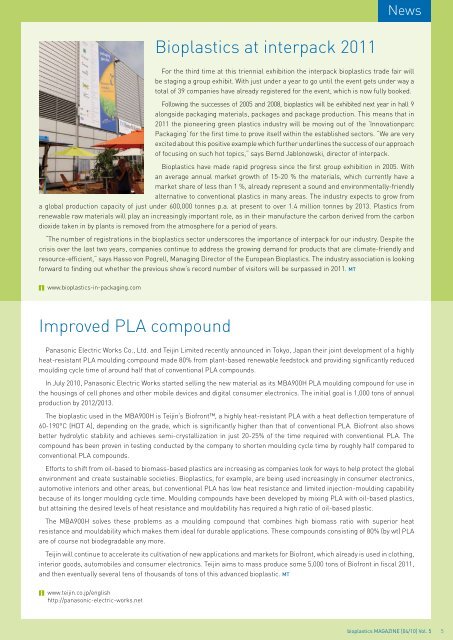04 | 2010
You also want an ePaper? Increase the reach of your titles
YUMPU automatically turns print PDFs into web optimized ePapers that Google loves.
News<br />
Bioplastics at interpack 2011<br />
For the third time at this triennial exhibition the interpack bioplastics trade fair will<br />
be staging a group exhibit. With just under a year to go until the event gets under way a<br />
total of 39 companies have already registered for the event, which is now fully booked.<br />
Following the successes of 2005 and 2008, bioplastics will be exhibited next year in hall 9<br />
alongside packaging materials, packages and package production. This means that in<br />
2011 the pioneering green plastics industry will be moving out of the ‘Innovationparc<br />
Packaging‘ for the first time to prove itself within the established sectors. “We are very<br />
excited about this positive example which further underlines the success of our approach<br />
of focusing on such hot topics,“ says Bernd Jablonowski, director of interpack.<br />
Bioplastics have made rapid progress since the first group exhibition in 2005. With<br />
an average annual market growth of 15-20 % the materials, which currently have a<br />
market share of less than 1 %, already represent a sound and environmentally-friendly<br />
alternative to conventional plastics in many areas. The industry expects to grow from<br />
a global production capacity of just under 600,000 tonnes p.a. at present to over 1.4 million tonnes by 2013. Plastics from<br />
renewable raw materials will play an increasingly important role, as in their manufacture the carbon derived from the carbon<br />
dioxide taken in by plants is removed from the atmosphere for a period of years.<br />
“The number of registrations in the bioplastics sector underscores the importance of interpack for our industry. Despite the<br />
crisis over the last two years, companies continue to address the growing demand for products that are climate-friendly and<br />
resource-efficient,“ says Hasso von Pogrell, Managing Director of the European Bioplastics. The industry association is looking<br />
forward to finding out whether the previous show‘s record number of visitors will be surpassed in 2011. MT<br />
www.bioplastics-in-packaging.com<br />
Improved PLA compound<br />
Panasonic Electric Works Co., Ltd. and Teijin Limited recently announced in Tokyo, Japan their joint development of a highly<br />
heat-resistant PLA moulding compound made 80% from plant-based renewable feedstock and providing significantly reduced<br />
moulding cycle time of around half that of conventional PLA compounds.<br />
In July <strong>2010</strong>, Panasonic Electric Works started selling the new material as its MBA900H PLA moulding compound for use in<br />
the housings of cell phones and other mobile devices and digital consumer electronics. The initial goal is 1,000 tons of annual<br />
production by 2012/2013.<br />
The bioplastic used in the MBA900H is Teijin’s Biofront, a highly heat-resistant PLA with a heat deflection temperature of<br />
60-190°C (HDT A), depending on the grade, which is significantly higher than that of conventional PLA. Biofront also shows<br />
better hydrolytic stability and achieves semi-crystallization in just 20-25% of the time required with conventional PLA. The<br />
compound has been proven in testing conducted by the company to shorten moulding cycle time by roughly half compared to<br />
conventional PLA compounds.<br />
Efforts to shift from oil-based to biomass-based plastics are increasing as companies look for ways to help protect the global<br />
environment and create sustainable societies. Bioplastics, for example, are being used increasingly in consumer electronics,<br />
automotive interiors and other areas, but conventional PLA has low heat resistance and limited injection-moulding capability<br />
because of its longer moulding cycle time. Moulding compounds have been developed by mixing PLA with oil-based plastics,<br />
but attaining the desired levels of heat resistance and mouldability has required a high ratio of oil-based plastic.<br />
The MBA900H solves these problems as a moulding compound that combines high biomass ratio with superior heat<br />
resistance and mouldability which makes them ideal for durable applications. These compounds consisting of 80% (by wt) PLA<br />
are of course not biodegradable any more.<br />
Teijin will continue to accelerate its cultivation of new applications and markets for Biofront, which already is used in clothing,<br />
interior goods, automobiles and consumer electronics. Teijin aims to mass produce some 5,000 tons of Biofront in fiscal 2011,<br />
and then eventually several tens of thousands of tons of this advanced bioplastic. MT<br />
www.teijin.co.jp/english<br />
http://panasonic-electric-works.net<br />
bioplastics MAGAZINE [<strong>04</strong>/10] Vol. 5


















